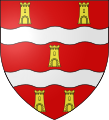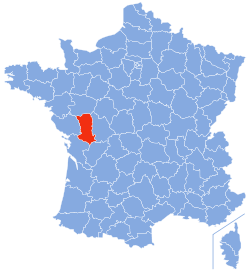Deux-Sèvres
Deux-Sèvres (French pronunciation: [dø sɛvʁ] (![]()
Deux-Sèvres | |
|---|---|
 The town hall of Thouars | |
 Coat of arms | |
 Location of Deux-Sèvres in France | |
| Coordinates: 46°30′N 00°20′E | |
| Country | France |
| Region | Nouvelle-Aquitaine |
| Prefecture | Niort |
| Subprefectures | Bressuire Parthenay |
| Government | |
| • President of the General Council | Eric Gautier (PS) |
| Area | |
| • Total | 5,999 km2 (2,316 sq mi) |
| Population (2016) | |
| • Total | 374,743 |
| • Rank | 65th |
| • Density | 62/km2 (160/sq mi) |
| Time zone | UTC+1 (CET) |
| • Summer (DST) | UTC+2 (CEST) |
| Department number | 79 |
| Arrondissements | 3 |
| Cantons | 17 |
| Communes | 256 |
| ^1 French Land Register data, which exclude estuaries, and lakes, ponds, and glaciers larger than 1 km2 | |
In history and literature
Deux-Sèvres was one of the 83 original départements created during the French Revolution on March 4, 1790.
Departmental borders were changed in 1973 when the inhabitants of the little commune of Puy-Saint-Bonnet became formally associated with the rapidly growing adjacent commune of Cholet. Cholet is in the neighbouring department of Maine-et-Loire. In order to avoid the associated communes being administered in separate departments, Puy-Saint-Bonnet was transferred into Maine-et-Loire.
Deux-Sevres features in Son Excellence Eugene Rougon, a novel by Emile Zola in his Rougon-Macquart series, when Rougon visits Niort, the departmental capital, to open a new rail line to Angers (chapter 10).
Geography and economics
The climate is mild, the annual temperature averaging 11 degrees Celsius.
The département remains rural: three-quarters of the area consists of arable land. Wheat and oats are the main products grown, as well as potatoes, apples, and walnuts. Niort is the center for growing vegetables and angelica. Some beetroot is grown in the district of Melle. Vineyards are numerous in the north (Haut-poitou (AOVDQS)), and there are some in the south.
The département is also well known for the breeding of cattle, mules, and horses. The Parthenais breed of cattle is named after the town of Parthenay in the north of the département. Also, dairy products are produced in significant quantities (butter in Échiré and goats' cheese).
Some quarries are in operation (in Mazières-en-Gâtine, La Peyratte or Saint-Varent), as well as lime extraction operations.
Textiles, leather-tanning, and flour milling were the traditional industries of Niort, the capital and major city. Nowadays, Niort, with 60,000 inhabitants, is an important commercial and administrative center. In particular it is one of the main financial centers in France (fourth in rank after Paris, Lyon and Lille). Niort is the national headquarters of some of the major insurance companies in France (Mutuelle d'assurance des artisans de France (MAAF), Mutuelle assurance des commerçants et industriels de France et des cadres et des salariés de l'industrie et du commerce (MACIF), Mutuelle d'assurance des instituteurs de France (MAIF) and others) and regional headquarters of others such as Groupama. The regional headquarters of several national banks, including Banque Populaire and Crédit Agricole, are also located there. The services sector is also heavily represented in Niort, in consulting, accounting, brokerage and software. Chemistry, pharmacy (Boiron) and aeronautics (Zodiac Group, Leach International)[1] are the main industries.
Textiles and shoe making, furnitures, mechanics, automotive (Heuliez and Irisbus), chemistry (Rhodia in Melle), food industry and food packaging are the major industries outside of the capital.
The unemployment rate in the département is very low (less than 5%) especially in the north-west, where many small and medium companies are developing rapidly.
The south-west of the département attracts tourists with the Marais Poitevin natural area; the Atlantic coast is close at hand.
Demographics
Population development since 1801:
| Year | Pop. | ±% p.a. |
|---|---|---|
| 1801 | 241,916 | — |
| 1806 | 254,105 | +0.99% |
| 1821 | 279,845 | +0.65% |
| 1831 | 288,260 | +0.30% |
| 1841 | 310,203 | +0.74% |
| 1851 | 323,615 | +0.42% |
| 1861 | 328,817 | +0.16% |
| 1872 | 331,243 | +0.07% |
| 1881 | 350,103 | +0.62% |
| 1891 | 354,282 | +0.12% |
| 1901 | 342,474 | −0.34% |
| 1911 | 337,627 | −0.14% |
| 1921 | 310,060 | −0.85% |
| 1931 | 308,481 | −0.05% |
| 1936 | 308,841 | +0.02% |
| 1946 | 312,756 | +0.13% |
| 1954 | 312,842 | +0.00% |
| 1962 | 321,118 | +0.33% |
| 1968 | 326,467 | +0.28% |
| 1975 | 335,829 | +0.40% |
| 1982 | 342,812 | +0.29% |
| 1990 | 346,173 | +0.12% |
| 1999 | 344,392 | −0.06% |
| 2006 | 359,711 | +0.62% |
| 2011 | 370,939 | +0.62% |
| 2016 | 374,743 | +0.20% |
| source:[2] | ||
Politics
Current National Assembly Representatives
Transport
Niort in the south of the département is connected to Paris and Bordeaux by the A10 motorway, with Nantes by the A83, with La Rochelle and Poitiers by the N11. Another important road in the north of the département is the Route nationale 149 (RN149), which runs roughly east–west from Bressuire to Poitiers, passing around the outskirts of Parthenay. This section of the RN149 forms part of the European route E62 from Nantes to Genoa. The road originally ran from Nantes, but has been bypassed in various stages by the new RN249 dual carriageway. The old section from Nantes to Bressuire has been either renamed or downgraded to the D149.
The north and south of the département are connected by relatively minor roads, with the D743 and D748 linking Niort to Parthenay and Bressuire respectively, whilst the D938 connects to Thouars.[4]
The département has two railway stations on the TGV route between Paris and La Rochelle (Niort and Saint-Maixent), with a journey from Niort to Paris taking 2h15. It is also served by several TER Nouvelle-Aquitaine regional railway routes, including a route from Poitiers via Niort to La Rochelle, a route from Niort to Saintes, and a route from Tours to Thouars and Bressuire. A railway bus service operated as part of the TER Nouvelle-Aquitaine network follows the RN149 from Poitiers to Nantes, calling at Parthenay and Bressuire. Additionally the département provides the Réseau des Deux-Sèvres, an inter-urban bus service that connects the towns and villages of the département.[5][6][7]
There are no airports with scheduled airline service within the département, although Niort-Souche Airport is used for private movements. The nearest commercial airports are at Poitiers (Poitiers - Biard Airport), La Rochelle (La Rochelle - Île de Ré Airport) and Nantes (Nantes Atlantique Airport).
Births
Famous births in the département:
- Françoise d'Aubigné, marquise de Maintenon (1635–1719), second wife of Louis XIV
- Jacques de Liniers (Santiago de Liniers y Bremond) (1753–1810)
- Louis-Marcelin, marquis de Fontanes (1757–1821), poet and politician
- Henri-Georges Clouzot (1904–1977), film director
- Laurent Cantet (1961), Palme d'Or at the Festival de Cannes 2008, for the movie Entre les murs
- Catherine Breillat (1948), film maker and novelist
- Jean-Hugues Anglade (1955), actor
- René Caillié (1799–1838) explorer, and the first European to return alive from the town of Timbuktu
Famous people related to the département:
- Jean-Baptiste Baujault, French sculptor
- Ségolène Royal (1953), former candidate for the 2007 French presidential election, former representative of the department at the National Assembly, former President of the Poitou-Charentes region (2004-2014) and Minister of Ecology since 2014.
See also
References
- "Archived copy". Archived from the original on 2016-03-04. Retrieved 2013-03-28.CS1 maint: archived copy as title (link)
- Site sur la Population et les Limites Administratives de la France
- http://www.assemblee-nationale.fr/
- Carte de Promenade - 33 - Cholet Niort. Institut Géographique National.
- "TGV". SNCF. Archived from the original on 2014-05-21. Retrieved 2008-08-14.
- "Ter-sncf.com - Poitou Charentes - Carte et Horaires". SNCF. Retrieved 2008-05-04.
- "Plan-RDS" (PDF). Conseil général des Deux-Sèvres. 2008. Archived from the original (PDF) on 2008-11-15. Retrieved 2008-06-04.
External links
| Wikimedia Commons has media related to Deux-Sèvres. |
- (in French) Prefectures website
- (in French) General council website


